1995 OLDSMOBILE SILHOUETTE service
[x] Cancel search: servicePage 276 of 390
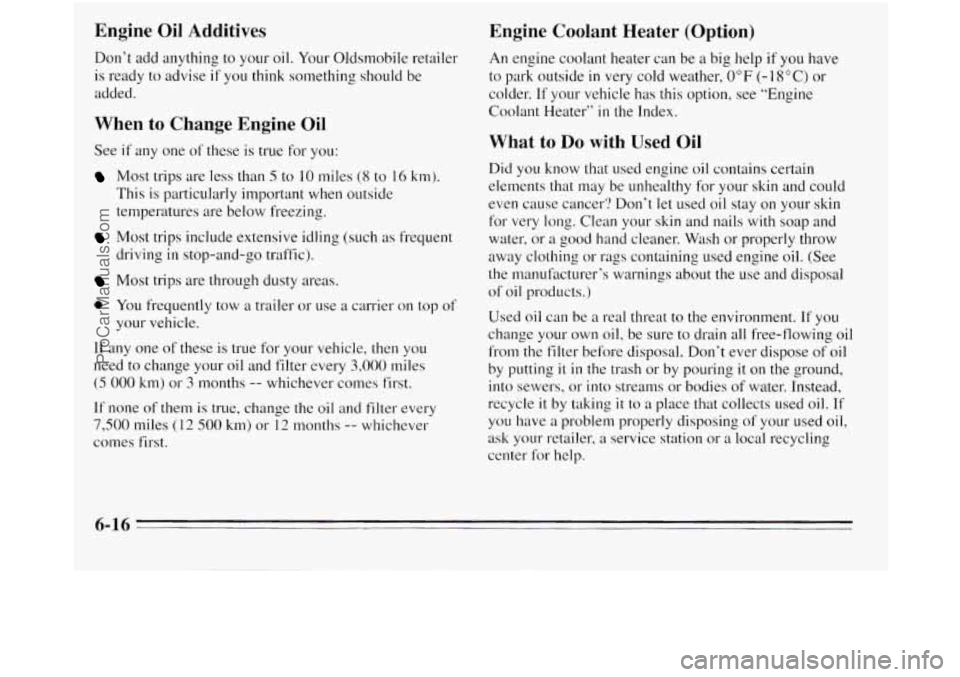
Engine Oil Additives
Don’t add anything to your oil. Your Oldsmobile retailer
is ready
to advise if you think something should be
added.
When to Change Engine Oil
See if any one of these is true for you:
Most trips are less than 5 to 10 miles (8 to 16 krn).
This
is particularly important when outside
temperatures are below freezing.
Most trips include extensive idling (such as frequent
driving
in stop-and-go traffic).
Most trips are through dusty areas.
0 You frequently tow a trailer or use a carrier 011 top of
your vehicle.
If any one
of these is true for your vehicle, then you
need to change your oil and filter every
3,000 miles
(5 000 km) or 3 months -- whichever comes first.
If none
of them is true, change the oil and filter every
7,500 miles (12 500 km) or I2 months -- whichever
comes first.
Engine Coolant Heater (Option)
An engine coolant heater can be a big help if you have
to park outside
in very cold weather, 0°F (- 18OC) or
colder.
If your vehicle has this option, see “Engine
Coolant Heater”
in the Index.
What to Do with Used Oil
Did you know that used engine oil contains certain
elements that may
be unhealthy for your skin and could
even cause cancer? Don’t let used oil stay on your skin
for very long. Clean your skin and nails with soap and
water, or
a good hand cleaner. Wash or properly throw
away clothing or rags containing used engine oil. (See
the manufacturer’s warnings about the use and disposal
of oil products.)
Used oil can be
a real threat to the environment. If you
change your own oil, be sure
to drain all free-flowing oil
from the filter before disposal. Don’t ever dispose of oil
by putting it
in the trash or by pouring it on the ground,
into sewers, or into streams or bodies of water. Instead,
recycle
it by taking it to a place that collects used oil. If
you have a problem properly disposing of your used oil,
ask your retailer, a service station or a local recycling
center for help.
6-16
ProCarManuals.com
Page 277 of 390
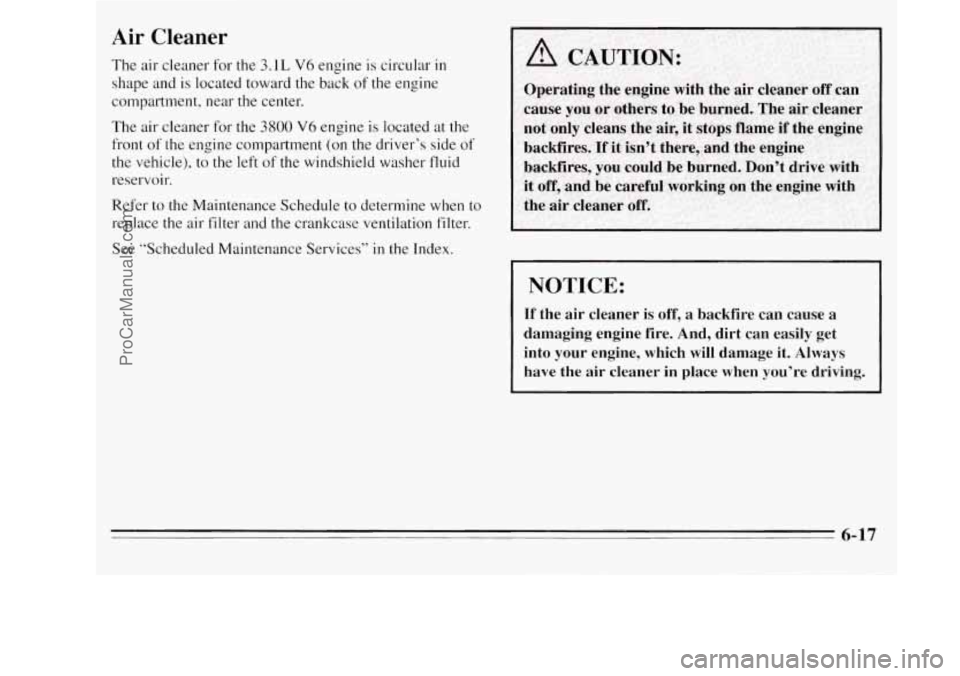
Air Cleaner
The air cleaner for the 3.1L V6 engine is circular in
shape and is located toward the back of the engine
compartment, near the center.
The air cleaner for the 3800 V6 engine is located at the
front
of the engine compartment (on the driver’s side of
the vehicle), to the left of the windshield washer fluid
reservoir.
Refer to the Maintenance Schedule
to determine when to
replace the air filter and the crankcase ventilation filter.
See “Scheduled Maintenance Services’’
in the Index.
I NOTICE:
If the air cleaner is off, a backfire can cause a
damaging engine fire. And, dirt can easily get into your engine, which
will damage it. Always
have the air cleaner in place when you’re driving.
ProCarManuals.com
Page 279 of 390
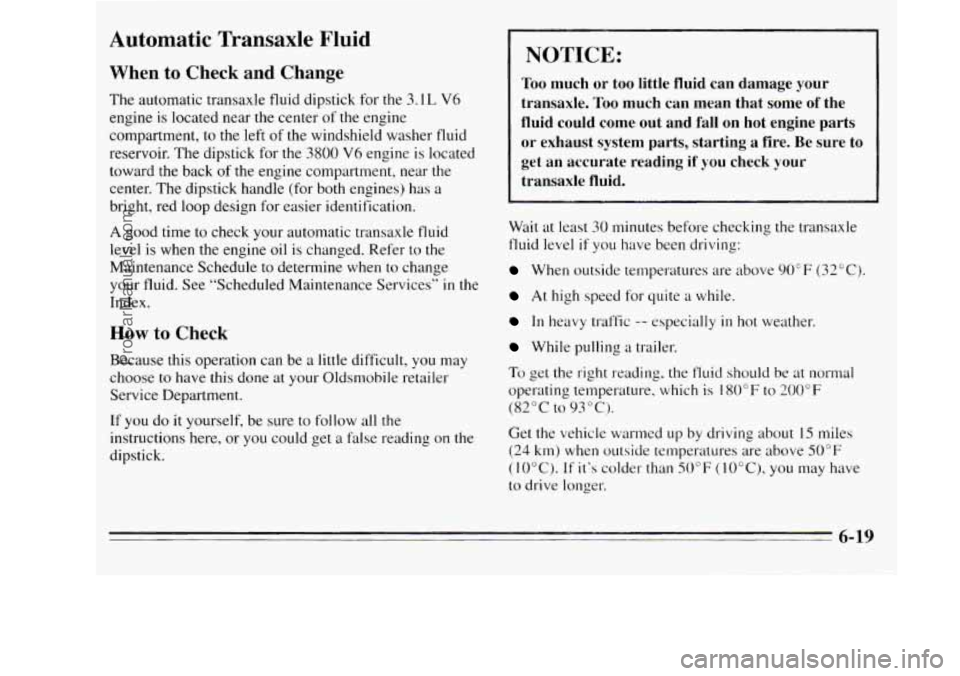
Automatic Transaxle Fluid
When to Check and Change
The automatic transaxle fluid dipstick for the 3.1 L V6
engine is located near the center of the engine
compartment, to the left
of the windshield washer fluid
reservoir. The dipstick for
the 3800 V6 engine is located
toward the back
of the engine Compartment, near the
center. The dipstick handle (for both engines) has
a
bright, red loop design for easier identification.
A good time to check your automatic transaxle fluid
level is when the engine oil is changed. Refer to the
Maintenance Schedule to determine when to change
your fluid. See “Scheduled Maintenance Services”
in the
Index.
How to Check
Because this operation can be a little difficult, you may
choose to have this done at your Oldsmobile retailer
Service Department.
If
you do it yourself, be sure to follow all the
instructions here, or
you could get a false reading on the
dipstick.
NOTICE:
Too much or too little fluid can damage your
transaxle.
Too much can mean that some of the
fluid could come out and fall on hot engine parts
or exhaust system parts, starting a fire. Be sure to
get
an accurate reading if you check your
transaxle fluid.
Wait at least 30 minutes before checking the transaxle
fluid level
if you have been driving:
When outside temperatures are above 90°F (32°C).
At high speed for quite a while.
In heavy traffic -- especially in hot weather.
While pulling a trailer.
To get the right reading, the fluid should be at normal
operating temperature, which is 180°F
to 200°F
(82°C to 93°C).
Get the vehicle warmed up by driving about 15 miles
(24 km) when outside temperatures are above 50°F
(10°C).
If it’s colder than 50°F (lO°C), you may have
to drive longer.
ProCarManuals.com
Page 296 of 390
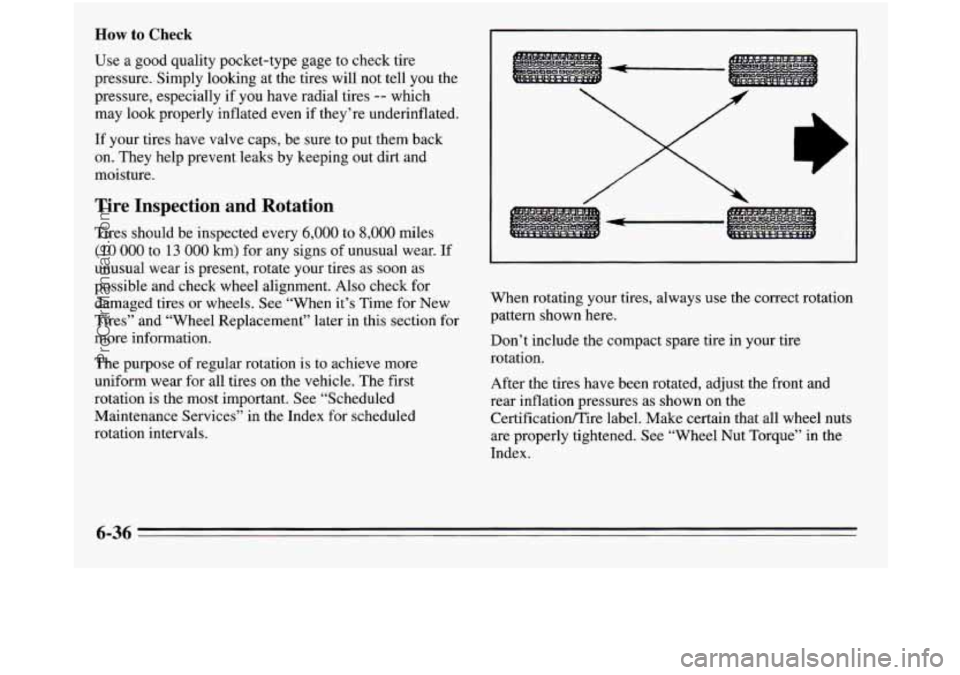
How to Check
Use a good quality pocket-type gage to check tire
pressure. Simply looking at the tires will not tell you the
pressure, especially if you have radial tires
-- which
may look properly inflated even if they’re underinflated.
If your tires have valve caps, be sure to put them back
on. They help prevent leaks by keeping out dirt and
moisture.
Tire Inspection and Rotation
Tires should be inspected every 6,000 to 8,000 miles
(1 0 000 to 13 000 km) for any signs of unusual wear. If
unusual wear is present, rotate your tires as soon as
possible and check wheel alignment. Also check for
damaged tires or wheels. See “When it’s Time for New
Tires” and “Wheel Replacement” later in this section for
more information.
The purpose
of regular rotation is to achieve more
uniform wear for all tires on the vehicle. The first
rotation is the most important. See “Scheduled
Maintenance Services” in the Index for scheduled
rotation intervals. When
rotating your tires, always use the correct rotation
pattern shown here.
Don’t include the compact spare tire in your tire
rotation.
After the tires have been rotated, adjust the front and
rear inflation pressures as shown on
the
Certificatioflire label. Make certain that all wheel nuts
are properly tightened. See “Wheel Nut Torque” in the
Index.
6-36
ProCarManuals.com
Page 298 of 390

Buying New Tires
To find out what kind and size of tires you need, look at
the CertificatiordTire label.
The tires installed
on your vehicle when it was new had
a Tire Performance Criteria Specification
(TPC Spec)
number on each tire’s sidewall. When
you get new tires,
get ones with that same
TPC Spec number. That way,
your vehicle will continue to have tires that are designed
to give proper endurance, handling, speed rating,
traction, ride and other things during normal service on
your vehicle.
If your tires have an all-season tread
design, the TPC number will be followed by an
“MS”
(for mud and snow).
If you ever replace your tires with those not having a
TPC Spec number, make sure they are the same size,
load range, speed rating and construction type (bias,
bias-belted or radial) as your original tires.
Uniform Tire Quality Grading
The following information relates to the system
developed by the United States National Highway
Traffic Safety Administration which grades tires by
treadwear, traction and temperature performance.
(This
applies only to vehicles sold in the United States.)
6-38
ProCarManuals.com
Page 299 of 390
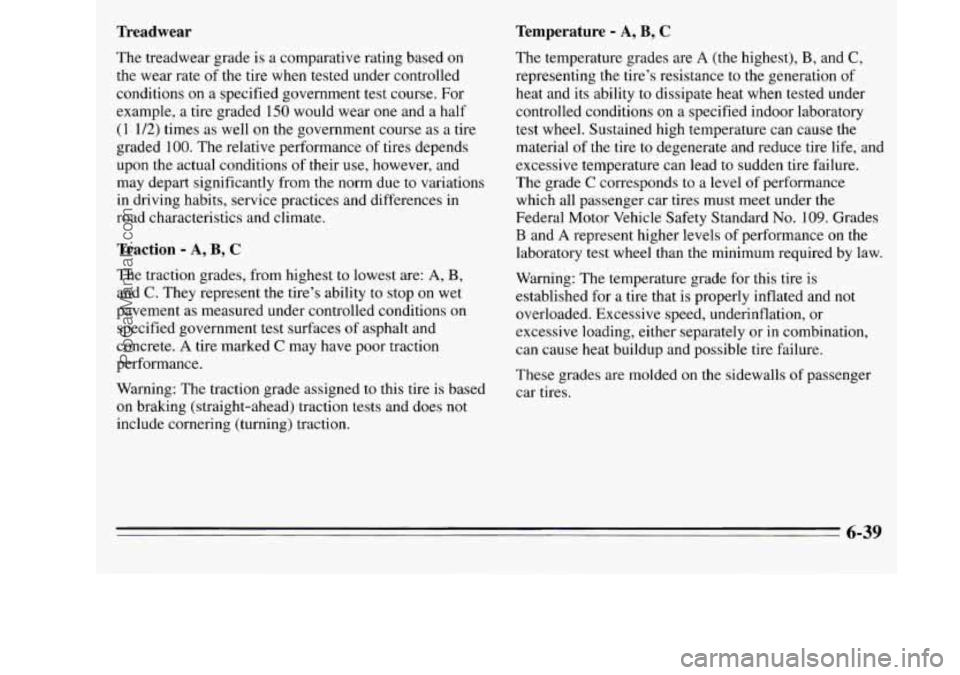
Treadwear Temperature - A, B, C
The temperature grades are A (the
highest), B, and C,
representing the tire’s resistance to the generation of
heat and its ability to dissipate heat when tested under
controlled conditions on a specified indoor laboratory
test wheel. Sustained high temperature can cause the
material of the tire to degenerate and reduce tire life, and
excessive temperature can lead to sudden tire failure.
The grade
C corresponds to a level of performance
which all passenger car tires must meet under the
Federal Motor Vehicle Safety Standard
No. 109. Grades
B and A represent higher levels of performance on the
laboratory test wheel than the minimum required by law.
The treadwear grade
is a comparative rating based on
the wear rate of the tire when tested under controlled
conditions on a specified government test course. For
example, a tire graded
150 would wear one and a half
(1 1/2) times as well on the government course as a tire
graded
100. The relative performance of tires depends
upon the actual conditions
of their use, however, and
may depart significantly from the norm due to variations
in driving habits, service practices and differences
in
road characteristics and climate.
Traction - A, B, C
The traction grades, from highest to lowest are: A, B,
and C. They represent the tire’s ability to stop on wet
pavement as measured under controlled conditions on
specified government test surfaces
of asphalt and
concrete.
A tire marked C may have poor traction
performance.
Warning: The traction grade assigned
to this tire is based
on braking (straight-ahead) traction tests and does not
include cornering (turning) traction. Warning:
The temperature grade for this tire is
established for a tire that
is properly inflated and not
overloaded. Excessive speed, underinflation, or
excessive loading, either separately or in combination,
can cause heat buildup and possible tire failure.
These grades are molded on the sidewalls
of passenger
car tires.
6-39
ProCarManuals.com
Page 308 of 390

Exterior painted surfaces are subject to aging, weather
and chemical fallout, that can take their toll over
a
period of years. You can help to keep the paint finish
looking new by keeping your Oldsmobile garaged or
covered whenever possible.
Aluminum Wheels
Tires
To clean your tires, use a stiff brush with a tire cleaner.
When applying
a tire dressing always take care to wipe
off any overspray or splash from painted surfaces.
Petroleum-based products may damage the paint finish.
Your aluminum wheels have
a protective coating similar Finish Damage
to the painted surface of your vehicle. Don’t use strong Any stone chips, fractures or deep scratches in the finish
soaps, chemicals, chrome polish, abrasive cleaners or should be repaired right away.
abrasive cleaning brushes on them because yo~l could
damage this coating. After rinsing thoroughly,
a wax
may be applied. Minor
chips and scratches can be repaired with touch-up
materials available from your retailer or other service
outlets. Larger areas of finish damage can be corrected
in your retailer’s body and paint shop.
NOTICE: Underbody Maintenance
Don’t use an automatic car wash that has hard
silicon carbide cleaning brushes. These brushes
can take the protective coating
off your
underbody parts such as fuel lines, frame, floor pan, and aluminum wheels.
removed, accelerated corrosion (rust) can occur on the
Chemicals used
for ice and snow removal and dust
control can collect on the underbody. If these are not
exhaust system even though they have corrosion
protection.
6-48
ProCarManuals.com
Page 311 of 390
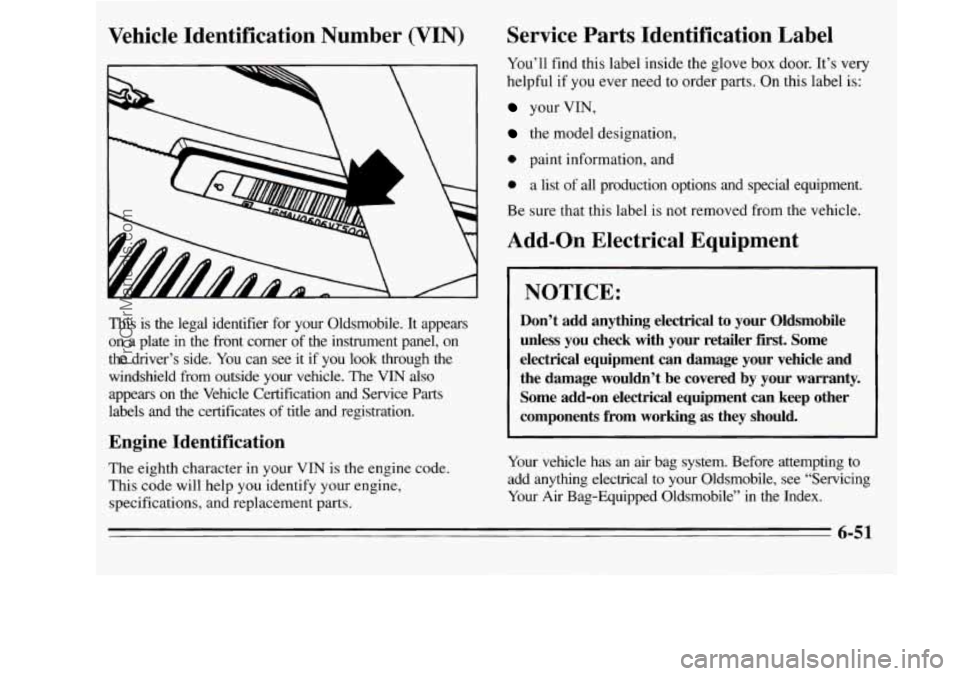
Vehicle Identification Number (VIN)
This is the legal identifier for your Oldsmobile. It appears
on a plate in the front corner of the instrument panel, on
the driver’s side. You can see it if you look through
the
windshield from outside your vehicle. The VIN also
appears
on the Vehicle Certification and Service Parts
labels and the certificates of title and registration.
Engine Identification
The eighth character in your VIN is the engine code.
This code will help you identify your engine,
specifications, and replacement parts.
Service Parts Identification Label
You’ll find this label inside the glove box door. It’s very
helpful if you ever need to order parts. On this label is:
your VIN,
the model designation,
0 paint information, and
0 a list of all production options and special equipment.
Be sure that this label is not removed from the vehicle.
Add-on Electrical Equipment
NOTICE:
Don’t add anything electrical to your Oldsmobile
unless you check with your retailer first. Some
electrical equipment can damage your vehicle and
the damage wouldn’t be covered
by your warranty.
Some add-on electrical equipment can keep other
components from working
as they should.
Your vehicle has an air bag system. Before attempting to
add anything electrical to your Oldsmobile, see “Servicing Your
Air Bag-Equipped Oldsmobile” in the Index.
6-51
ProCarManuals.com